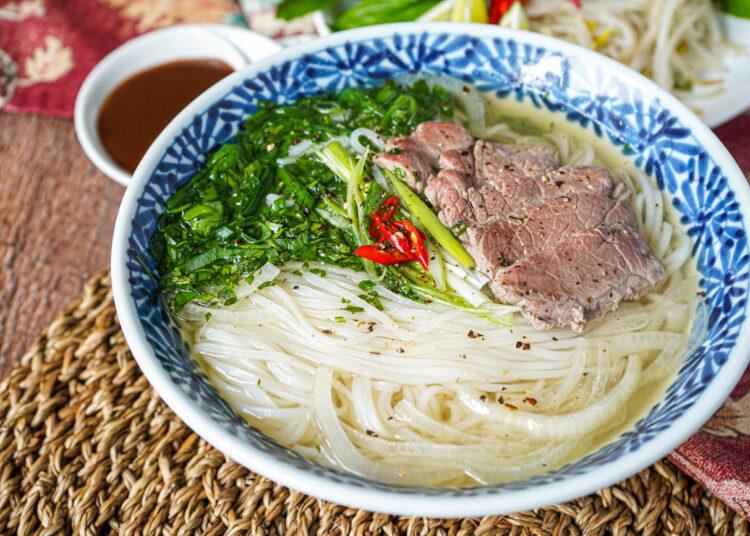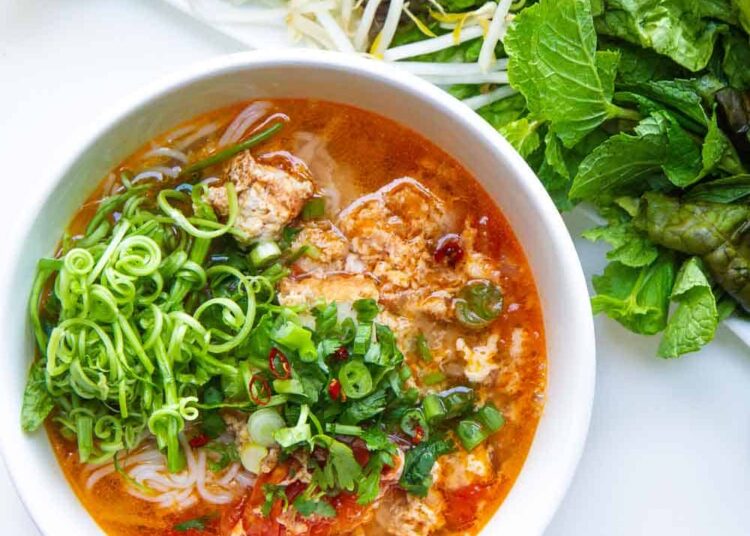To understand the differences between bun noodles and pho noodles, we will delve into the definition of both types. Discover the essence of bun noodles and the distinct characteristics that set them apart from pho noodles. Gain insights into these variations and enhance your understanding of these popular noodle dishes.
Definition of Bun Noodles
Bun noodles, also known as rice vermicelli noodles, are a type of thin and delicate Asian noodles made from rice flour. They’re often used in dishes like Vietnamese bun cha and Malaysian laksa.
Here’s a table outlining the definition of bun noodles:
| Characteristics | Description |
|---|---|
| Origin | Southeast Asia |
| Appearance | Thin, translucent strands |
| Texture | Soft and smooth |
| Cooking method | Quick and easy to cook |
| Usage | Versatile; can be used in soups, stir-fries, salads, and spring rolls |
| Nutritional value | Low fat and cholesterol-free; a good source of carbohydrates |
Also, they’re gluten-free, making them perfect for people with gluten sensitivities or celiac disease.
Did you know that bun noodles have been enjoyed for centuries? This noodle variety has been a staple in Southeast Asian cuisine since the olden days.
Definition of Pho Noodles

Pho Noodles – a traditional Vietnamese dish – has a balance of flavors and fragrant aromas. Let’s explore its unique characteristics!
- Broth made from simmering bones, herbs, spices for hours – aromatic and savory.
- Rice Noodles – thin, flat, made from rice flour – a light but satisfying texture.
- Toppings such as thinly sliced beef/chicken, bean sprouts, herbs, lime, chili sauce.
The combination of textures adds to the experience – soft noodles, crunchy bean sprouts, tender meat, aromatic broth. For an even better Pho Noodle experience, customize your toppings with extra herbs, try seafood/tofu instead of meat, adjust the spice level by adding chili sauce/sriracha, explore regional variations. Embrace the variety and make it your own!
Origin and Cultural Significance
To understand the origin and cultural significance of bun noodles vs pho noodles, dive into the intriguing history behind each. Discover the roots of bun noodles and the unique stories attached to pho noodles. Uncover the rich cultural heritage and influences that shape these beloved culinary delights.
Origin and History of Bun Noodles
Bun Noodles have a long legacy in Chinese culture, stemming from ancient China. They are associated with special occasions and celebrations. Ingredients such as wheat flour, water, salt, and sometimes eggs or flavorings are used to prepare these noodles. The dough is kneaded, rolled, and cut into thin strips. Bun Noodles are boiled or stir-fried before being served.
These noodles have been embraced by many regions in China. They are renowned for their ability to absorb the flavors of the ingredients they are cooked with. A legendary chef in the Song dynasty is said to have come up with the recipe for Bun Noodles. This tasty creation quickly gained popularity throughout the country.
Nowadays, Bun Noodles are enjoyed around the world. They represent the culinary artistry of generations past, and will continue to be cherished for years to come.
Origin and History of Pho Noodles
Pho noodles have a deep and exciting history. It’s believed to have come from French and Chinese cuisine, during the French colonial period in the early 20th century. Local chefs started making it by incorporating beef into their traditional rice noodle soup dishes.
It became popular among the working-class in northern Vietnam, and spread quickly. People ate it during tough times like war and famine, as it was affordable and had lots of flavor.
What truly makes pho noodles unique is its broth. It’s made by simmering beef bones with aromatics like ginger, onions, and star anise. The broth is full of flavor. You add thinly sliced beef or chicken, which cooks in the hot broth.
To make it even better, add lime juice and fresh herbs. Like Thai basil or cilantro. Try different condiments too, like sriracha and hoisin sauce. Plus, don’t forget the garnishes! Bean sprouts, chili peppers, and lime wedges.
Pho noodles capture the hearts of people all over. It’s a symbol of tradition, resilience, and joy in simplicity. So, don’t miss the chance to enjoy its flavors and its history!
Ingredients and Preparation
To understand the difference between bun noodles and pho noodles, delve into their respective ingredients and preparation. Explore the unique characteristics of bun noodles, as well as the distinctive ingredients and techniques used in their preparation. Similarly, discover the key components and methods involved in creating the flavorful and aromatic pho noodles.
Ingredients and Preparation of Bun Noodles
Bun noodles, a dish of deliciousness with delightful flavors and textures, is made with a special mix of components. Let’s look at the alluring ingredients and how this yummy dish is made.
Here’s a table with the bun noodles ingredients and prep:
| Ingredients | Quantity |
|---|---|
| Noodles | 200g |
| Ground pork | 150g |
| Shrimp | 100g |
| Bean sprouts | 100g |
| Carrots | 1, sliced |
| Scallions | 2, chopped |
| Garlic | 3 cloves |
| Ginger | 1-inch bit |
| Soy sauce | 2 TBSP |
| Oyster sauce | 1 TBSP |
| Fish sauce | 1 TBSP |
| Sesame oil | 1 TBSP |
First, cook the noodles as per directions on the package. In another pan, heat oil and fry garlic until it’s fragrant. Add pork and shrimp, cooking until they’re done. Then add carrots and sprouts, stir-frying for a few minutes. Incorporate scallions, ginger, soy, oyster, fish sauce, and sesame oil.
Combine everything well. Then add the cooked noodles to the pan. Gently mix everything so that all flavors combine nicely.
Here’s a fun story about bun noodles. On my journey to Vietnam, I had the chance to taste genuine bun noodles in a busy market. The smell of spices was in the air as I watched skilled chefs make this dish in big woks. The vendors happily shared their family recipes, passing down generations of culinary skill.
Ingredients and Preparation of Pho Noodles
Pho noodles are a yummy Vietnamese treat that needs certain ingredients and special techniques. Let us explore the details and find out how to make this scrumptious meal!
Let’s start by taking a look at the necessary components for preparing pho noodles. This list will show you what you need:
| Ingredient | Quantity |
|---|---|
| Beef bones | 2 pounds |
| Onion | 1 large |
| Ginger | 3-inch piece |
| Star anise | 2 pods |
| Cinnamon stick | 1 |
| Cloves | 3 |
| Cardamom pods | 2 |
| Fish sauce | ¼ cup |
| Rock sugar | 1 tablespoon |
| Rice noodles | As per preference |
Now, let us look at some special points worth noting. It is essential to blanch the beef bones before using them in the broth. This step helps clear out any dirt and make the soup base more delicious and flavorful.
Also, while simmering the broth, make sure to skim off any foam or unwanted particles that come up. This will keep the broth transparent and give it a great taste.
Here are some ideas to take your pho noodles experience to the next level:
- Throw in some fresh herbs like Thai basil, cilantro, and mint leaves as garnish. These herbs add beautiful colors and a nice smell to your dish.
- Another suggestion is to serve pho noodles with lime wedges and bean sprouts. Squeezing lime juice over your bowl of pho adds a tangy flavor, while bean sprouts give a nice crunch.
Flavors and Taste Profile
To understand the flavors and taste profile of bun noodles versus pho noodles, explore the sub-sections: flavors and taste profile of bun noodles and flavors and taste profile of pho noodles. These subsections will shed light on the distinct flavor profiles that make each dish unique in their own delicious way.
Flavors and Taste Profile of Bun Noodles
Bun noodles tantalize taste buds with their unique flavors and taste profile. A combination of ingredients and cooking techniques provide a one-of-a-kind experience. Let’s get to know the flavors better using a table!
It will show us the different components of bun noodles’ taste:
| Flavor Component | Description |
|---|---|
| Spiciness | Chili peppers or spicy sauces give it a kick! |
| Umami | Richness from soy sauce, fish sauce, or mushrooms. |
| Sweetness | Harmony from sugar or mirin. |
| Saltiness | Saltiness ensures proper seasoning without overpowering. |
| Sourness | Tanginess from vinegar or citrus juice adds brightness. |
More details about bun noodles include the umami flavor from dried shrimp or seaweed. Additionally, cilantro or Thai basil add freshness and complexity.
History tells us that bun noodles were created as a portable meal for travelers. Over time, they gained popularity with locals who appreciated the flavors and heartwarming nature.
Flavors and Taste Profile of Pho Noodles
Pho noodles – an adored Vietnamese dish – offer an array of delightful flavors and taste profiles. Every bowl is a mix of savory, sweet, salty, and tangy notes that tantalize the tongue. Let’s explore the intricate realm of pho further!
Savory: Rich beef or chicken broth with spices like star anise and cinnamon.
Sweet: Flavorful slices of juicy meat or shrimp.
Salty: Fish sauce or soy sauce to enhance the umami flavor.
Tangy: Lime wedges for a zesty kick.
Also, pho has other unique elements that make it extraordinary. Fresh herbs like Thai basil, cilantro, and bean sprouts bring a burst of freshness. The combo of rice noodles and protein creates a fulfilling texture that keeps you wanting more!
Pro Tip: To upgrade your pho experience, add Sriracha or hoisin sauce for an additional flavor kick. Experience the interplay between the various tastes in each spoonful for an unforgettable culinary journey!
Noodle Shape and Texture
To understand the difference in noodle shape and texture between bun noodles and pho noodles, we explore the sub-sections: noodle shape and texture of bun noodles and noodle shape and texture of pho noodles. Each sub-section offers a unique solution to understanding the variations in appearance and mouthfeel of these popular noodle types.
Noodle Shape and Texture of Bun Noodles

Let’s explore the world of bun noodles! Different shapes and textures make for a unique eating experience. From smooth and round, to chewy and flat – there’s something for every palate.
Check out the table below for a visual:
| Shape | Texture | Description |
|---|---|---|
| Round | Smooth | These round bun noodles glide through your lips. Perfect for soups and stir-fries. |
| Flat | Al dente | Satisfying chewiness that adds depth to any dish. Hot or cold preparations. |
| Wavy | Silky | Wavy edges and silky texture, great with creamy sauces. |
| Twisted | Springy | Delightful springy bite. Perfect with meat dishes or vegetable stir-fries. |
There’s one more thing about bun noodles: their versatility. Adapting to different cuisines and flavors, they take on the sauces and ingredients they are cooked with.
Cultural traditions and customs also shape the noodles. Regions across the world have different ways of shaping them. Amazing how changing the shape can make such a difference!
Noodle Shape and Texture of Pho Noodles
Pho noodles come in various shapes and textures, each adding its own twist to the treasured Vietnamese meal.
| Shape | Texture |
|---|---|
| Flat | Soft |
| Round | Chewy |
| Ribbon | Silky |
Flat pho noodles bring a softness that absorbs the delicious broth. Round noodles deliver a chewy texture for an enjoyable crunch. For a smoother feel, ribbon-shaped noodles offer a silky sensation to complement the tasty broth.
Did you know? A legend claims that Madam Pho was the one who created pho noodles. One evening she made soup for her family and decided to use rice flour to make fresh noodles. The delicate ribbons of dough brought out the flavors of her soup in a way she’d never experienced before!
Broth and Serving Style
To understand the difference between bun noodles and pho noodles in terms of their broth and serving style, explore the benefits of each. Discover the distinct characteristics of the broth and serving style of bun noodles and pho noodles, allowing you to savor these delectable dishes in their unique and satisfying ways.
Broth and Serving Style of Bun Noodles
When it comes to bun noodles, the broth and serving style are key to making it a tasty experience. Let’s explore the different broths and styles!
First off, there are several types of broths used for bun noodles. Beef, chicken, and vegetable broths are the most common. These all simmer for hours with ingredients like ginger, garlic, and spices for maximum flavor.
Next up, the creative serving styles! One popular way is to serve the cooked noodles “dry”, without broth. They are tossed with sauces like soy sauce, chili oil, or peanut sauce for a unique texture.
Alternatively, you can have the noodles in a soup with toppings! Think pork or beef slices, herbs like cilantro and mint, fried shallots, bean sprouts, and lime wedges. The combination of flavors is amazing!
Pro Tip: Top it all off with condiments like hoisin sauce or sriracha for more flavor.
Broth and Serving Style of Pho Noodles
Pho noodles are famous for their tasty broth and peculiar serving style. The broth is made from bones and fragrant spices, making it the main part of this Vietnamese treat. The way it is served includes noodles in a bowl with bean sprouts, herbs, lime wedges, and condiments like hoisin sauce and Sriracha.
Here is a visual representation of the Broth and Serving Style of Pho Noodles:
| Broth | Serving Style |
|---|---|
| Beef | Traditional |
| Chicken | Vegetarian |
| Seafood | Family Style |
Furthermore, there are some extraordinary details. In Vietnam, different regions have different recipes for the pho broth, which may contain star anise and cinnamon sticks. Additionally, restaurants may offer proteins such as beef brisket, rare steak slices, meatballs, and tendon so you can personalize your bowl.
It is curious that pho originated in Northern Vietnam during the early 1900s. Nowadays, it is one of the most celebrated Vietnamese dishes in the world.
(Source: National Geographic)
Popular Variations and Regional Differences
To understand the popular variations and regional differences between bun noodles and pho noodles, dive into this section. Discover the distinct characteristics of popular variations of bun noodles and explore the unique aspects of popular variations of pho noodles.
Popular Variations of Bun Noodles
Bun noodles come in a multitude of variations. These offer unique flavors and styles, pleasing noodle lovers everywhere.
Popular Variations of Bun Noodles:
| Noodle Type | Region | Key Ingredients | Notable Characteristics |
|---|---|---|---|
| Pho | Vietnam | Rice noodles | Rich beef broth, tender meat slices, aromatic herbs |
| Pad Thai | Thailand | Rice noodles | Tangy tamarind sauce, shrimp/prawns, crushed peanuts |
| Ramen | Japan | Wheat noodles | Flavorful broth, various toppings (egg, pork, seaweed) |
| Jajangmyeon | South Korea | Wheat noodles | Black bean sauce with pork or seafood, diced vegetables |
| Spaghetti | Italy | Wheat noodles | Tomato-based sauce, meatballs/sausage, Parmesan cheese |
Each variation has its own unique culinary prowess. For instance, Pho from Vietnam has aromatic broth and tender meat slices. Pad Thai in Thailand mixes tangy tamarind sauce and rice noodles with shrimp. Japan’s Ramen stands out with its flavorful broths and toppings like egg and pork.
The table only shows some popular bun noodle variations. From China’s Dan Dan Noodles to Singapore’s Laksa, each has its own distinct flavor that reflects the local culture.
Experience different bun noodle variations! Explore these dishes and savor the flavors. Enjoy vibrant aromas and mouthwatering tastes – you won’t be disappointed!
Popular Variations of Pho Noodles
In Vietnam, where pho noodles were born, there are many awesome renditions of this dish. Let’s take a look at the various types, each with its own unique flavor and ingredients.
Pho Bo, or beef pho, is a classic version featuring slices of beef in a rich broth, plus herbs and spices. Pho Ga, or chicken pho, has tender chicken bathed in a tasty broth and herbs.
Then there’s Pho Hai San – a mix of shrimp, squid, and fish in a flavorful broth. For vegetarians, Pho Chay has tofu or veggies in place of meat, but with the same taste.
So what gives each variation its own twist?
- Protein: Pho Bo has beef, Pho Ga has chicken, and Pho Hai San has seafood.
- Broth: Aromatic spices like star anise, cinnamon, ginger, and cloves form the base of every pho.
- Toppings: Herbs, lime wedges, and bean sprouts make it even better.
- Noodles: Flat rice noodles are the staple.
Regional differences in Vietnam create different interpretations of these variations. For example, Southern-style pho has Hoisin sauce and chili paste, while Northern-style is simpler and focuses on the broth.
Fun Fact: Vietnam eats 5 million bowls of pho every day! [Source: The New York Times]
Nutritional Content
To understand the nutritional content of bun noodles and pho noodles, we will assess the differences between the two. Delve into the sub-sections, “Nutritional Content of Bun Noodles” and “Nutritional Content of Pho Noodles,” to gain insight into the specific health benefits and drawbacks of each variety.
Nutritional Content of Bun Noodles
Bun noodles – popular for their yummy taste & flexibility – have nutritional benefits too! Let’s learn more.
This tasty dish provides essential nutrients. Proteins, carbs, vitamins & minerals – bun noodles have it all! See the nutritional content table below:
| Nutrient | Amount per serving |
|---|---|
| Calories | 300 kcal |
| Protein | 10g |
| Carbohydrates | 50g |
| Fat | 5g |
| Fiber | 2g |
Plus, bun noodles are low in sodium & cholesterol. This makes them great for heart health & reducing salt intake. Enjoy them as part of a balanced diet.
Pro Tip: Add fresh veggies like carrots, broccoli or mushrooms to increase fiber & get more vitamins & minerals.
Nutritional Content of Pho Noodles
Pho noodles are a renowned Vietnamese dish known for its one-of-a-kind flavors and fragrant broth. To grasp the nutritional value of Pho noodles, let’s look closer at their composition. In a typical serving size, here’s what you’ll get:
Nutritional Content of Pho Noodles:
| Nutrient | Amount per Serving |
|---|---|
| Calories | 350 |
| Protein | 12g |
| Carbohydrates | 70g |
| Fat | 2g |
| Fiber | 4g |
Bear in mind that these values can differ based on what else you add. Pho noodles stand out since they are low in calories and fat. Plus, they offer carbs and protein. These macronutrients give energy and help with muscle repair and growth. Fiber also ensures good digestion.
As a bonus, Pho noodles are often served with fresh herbs, bean sprouts, lime wedges and chili peppers. These extras not only add to the flavor, but also provide essential vitamins and minerals.
Which One to Choose?
To make a decision between bun noodles and pho noodles, consider the following factors: the type of broth, the protein choices, the noodle texture, and the overall flavor profiles. Each of these sub-sections will provide insights into how these factors can influence your choice between bun noodles and pho noodles.
Factors to Consider When Choosing Between Bun Noodles and Pho Noodles
When it comes to choosing between bun and pho noodles, there are a few things to consider. Let’s look at the taste and texture. Pho noodles are thin and flat, while bun noodles are thick and round. Pho noodles are softer, while bun noodles are chewier. It’s up to you which one you prefer.
Next, let’s think about versatility. Pho noodles are used in Vietnamese soup dishes, while bun noodles can be used in salads and stir-fry. Bun noodles offer more options.
Cooking time is another factor. Pho noodles take longer than bun noodles. So, if you’re in a rush, bun noodles are the way to go.
Finally, let’s look at nutrition. Both types of noodles can be part of a healthy diet. But, bun noodles have more fiber. So, if you’re trying to increase your fiber intake, choose bun noodles.
In conclusion, it’s up to you to decide between bun and pho noodles. Think about taste, texture, versatility, cooking time, and nutrition before making your choice.
Conclusion
Bun noodles and pho noodles differ in how they are made and served. Bun noodles are generally made from rice flour, and eaten cold or at room temperature. Pho noodles are made from wheat flour and are served in hot broth.
Bun noodles have a firmer texture than pho noodles, and give a satisfying chewiness. They are also often served with fresh vegetables, herbs, and proteins such as grilled meats or shrimp.
Pho noodles originated in Northern Vietnam in the early 20th century. It was a combination of Vietnamese and French culinary traditions. Bun noodles come from Southern Vietnam, and are thought to be influenced by Chinese cuisine.
Posts You Might Like
Frequently Asked Questions
What is the difference between Bun noodles and Pho noodles?
Bun noodles are a type of thin rice noodles used in Vietnamese cuisine, while pho noodles are flat rice noodles primarily used in pho, a popular Vietnamese soup.
Are Bun noodles and Pho noodles cooked differently?
Yes, the cooking method for bun noodles and pho noodles differs. Bun noodles are typically boiled until they are tender, whereas pho noodles are often soaked in hot water to soften them before adding them to the soup.
How do Bun noodles and Pho noodles taste different?
Bun noodles have a light, chewy texture and a slightly sweet flavor. On the other hand, pho noodles are softer and have a neutral taste, allowing them to absorb the flavors of the soup they are served in.
Can I substitute Bun noodles for Pho noodles in a recipe?
While both noodles are made from rice, they have distinct textures and flavors. If you are looking to experience the authentic taste of a dish, it is recommended to use the specific noodle type mentioned in the recipe.
Which dishes are traditionally made with Bun noodles?
Bun noodles are commonly used in dishes like Bun Cha (grilled pork with noodles), Bun Bo Hue (spicy beef noodle soup), and Bun Rieu Cua (crab noodle soup).
Which dishes commonly use Pho noodles?
Pho noodles are primarily used in the popular Vietnamese soup called pho, which typically consists of beef or chicken broth, meat, and various herbs and vegetables.









